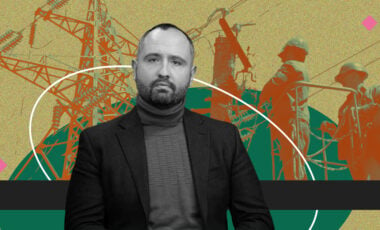Solutions to win: researchers unveil human capital index for Ukraine's recovery

In 2023, it is 6.4 on a ten-point scale. The index consists of health capital (this year is 6.0), adaptability capital (6.5), and social capital (6.6). Also, experts identified the drivers of each capitals, the state's work, and donors with which all these components can be strengthened.
This was discussed during the presentation of the Index of Social Cohesion and Stability (reSCORE) results for 2023, which focuses on stability, recovery, and reconstruction in Ukraine, which Rubryka attended.

Photo: Olha Stukalo. Slide dedicated to human capital for recovery
What is the problem?
Ukraine needs huge funds and intangible resources for reconstruction during and after the war. For donors to be able to provide support effectively and for the Ukrainian state to make informed decisions, objective data about the challenges and needs of Ukraine's society is needed.
How much have Ukrainians adjusted to the situation of war, how cohesive is the Ukrainian society, have they become less tolerant of corruption and truly more united and engaged, how well do local government officials communicate with community residents?
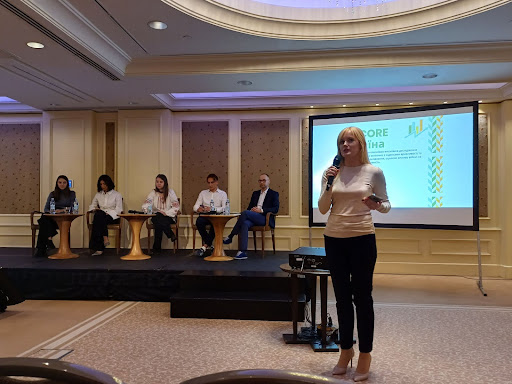
In this photo, taken by Olha Stukalo, you can see SeeD's data analysts Solomiia Myronovych and Pavlo Sereda, along with the head of the analytical department Marian Makhluzaridiz, junior researcher Nadiia Novosolova, senior researcher Ruslan Minich, and event moderator and reSCORE engagement specialist Anna Yemelianova, all standing from left to right.
What is the solution?
Specialists of the USAID Democratic Governance in Eastern Ukraine Program, the United Nations Development Program (UNDP), and the Center for Sustainable Peace and Democratic Development (SeeD) introduced the measurement of the Social Cohesion and Resilience Index (reSCORE). Before that, they measured SCORE — Index of Social Cohesion and Reconciliation — in Ukraine for seven years in a row. So, this year's data was compared with the SCORE index for 2021.
reSCORE Ukraine will be an annual recovery and reconstruction assessment tool informing national and international stakeholders' investments, priorities, policies, and program activities (specifically, USAID and UNDP).
The results of this year's study will also be used to support the government's and donors' coordinated efforts to develop and implement the National Recovery and Reconstruction Roadmap.
How does it work?
What the human capital index for recovery shows
From March to June 2023, specialists of the Center for Sustainable Peace and Democratic Development (SeeD) conducted a study of the Index of Social Cohesion and Stability in Ukraine with the participation of more than 5,900 respondents throughout Ukraine (excluding temporarily occupied territories).
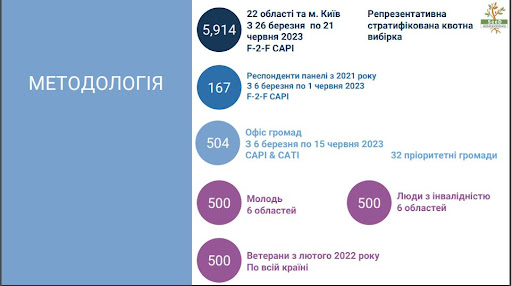
Photo: Olha Stukalo. reSCORE research methodology
They introduced a new research index: human capital for recovery. In addition, an index of the vulnerability of Ukrainians to traumatic events was determined.
Human capital for recovery is the knowledge, skills, and health of people they have acquired during their lives, as well as the internal desire and motivation to help restore and rebuild Ukraine.
The purpose of the human capital index for recovery is to emphasize the long-term development strategy, SeeD senior researcher Ruslan Minich noted.
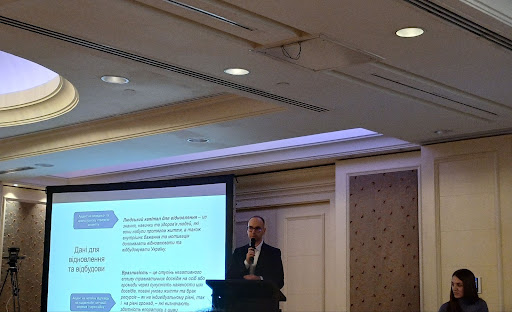
Photo: Olha Stukalo. SeeD senior researcher Ruslan Minich talks about human capital for recovery and vulnerability.
The Human Capital for Recovery Index is 6.4 out of 10, with room for improvement. The components of this index are health capital, adaptability capital, and social capital of our society.
Community capital is whether a person feels responsible for the future of their community and has control over decision-making both within the community and within the country.
Adaptability capital consists of such indicators as psychosocial well-being, self-development orientation, entrepreneurship, and stress resistance.
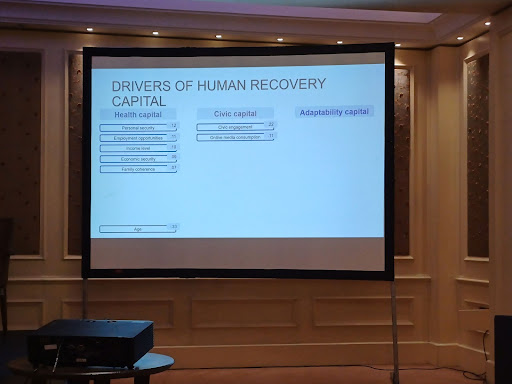
Photo: Olha Stukalo. Slide showing human capital drivers for recovery, including personal safety, employment opportunities, income levels, economic security, family cohesion, civic engagement, online media proliferationHealth capital has the lowest indicator compared to other capital components for recovery — 6.0. It consists of mental and physical health.
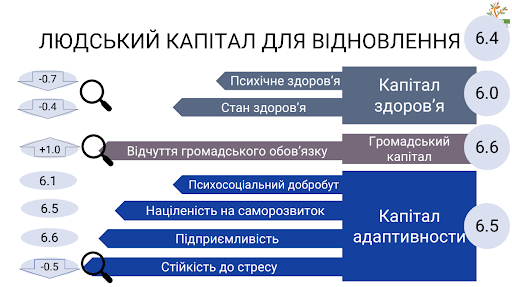
Photo: Olha Stukalo. A screenshot from the presentation showing how human capital indicators have changed
Compared to 2021, Ukraine sees a significant increase in social capital and a slight decrease in health capital and stress resistance, noted Ruslan Minich: "Therefore, policy can focus on these capitals: health capital, adaptability capital, namely stress resistance."
Vulnerability is mainly related to the lack of public activity. Although this indicator has generally increased, the level of interaction between local authorities and the community remains low, noted Ruslan Minich.
What are the general findings of the study?
Communities lack equipped shelters and psychological counseling services the most
Research topics include social cohesion, service delivery, human security, trust in institutions and political actors, civic attitudes and behavior, intergroup relations, political orientations, and traumatic experiences resulting from the full-scale Russian invasion.

Photo: Olha Stukalo. Solomiia Myronovych, Marian Makhluzaridiz, Nadiia Novosolova, Pavlo Sereda, and Ruslan Minich with a microphone
Among the results of the study are the following:
- Local institutions are trusted more than central ones (except the president). Respondents' confidence in Ukraine's armed forces is exceptionally high — 95%.
- Respondents perceive the provision of services mainly as high-quality.
- The level of corruption in Ukraine remains relatively high. SeeD data analyst Solomiia Mironovych noted that the study demanded more effective justice and fairness.
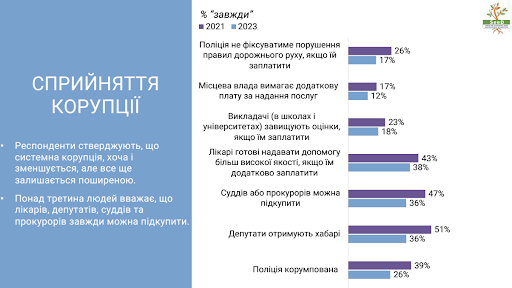
Photo: Olha Stukalo. Screenshot from the presentation of research results
- Further fight against corruption can improve the quality of health services for people with low incomes.
- Among the services to meet the basic safety and psychological health needs, the most lacking are equipped shelters and psychological counseling services. Three out of ten respondents also do not know about the latter's availability in their area, which may indicate a low interest in receiving psychological help.
- The fact of living in the occupation is not the biggest obstacle to intergroup harmony after liberation. On the other hand, respondents do not perceive pro-Russian attitudes and collaborationism.
- Ukrainian identity is generally inclusive.
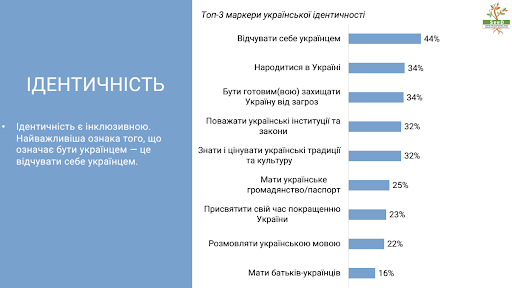
Photo: Olha Stukalo. Screenshot from the presentation of research results
According to the study results, the most vulnerable is the Kherson region (this caused some discussion in the hall), followed by the Rivne region.
Therefore, according to the researchers, the state policy of recovery and reconstruction can emphasize:
- at the personal level — on strengthening civic participation;
- at the household level — on improving material resources and mental health. That is, the state must ensure the availability of such services and inform the population well about it;
- at the level of communities — on strengthening security, particularly setting up shelters.
But in general, Tornike Zurabashvili said, head of SeeD's Eastern Europe department, we see Ukraine as stable, more united than ever, and optimistic about the future. According to the survey results, the sense of civic optimism remains very high throughout the country, and most Ukrainians believe that future generations will live better.
For reference:
It should be noted that the public organization "Dostupno.UA" has launched a project that will help implement inclusive reconstruction in Ukraine during and after the war.
In addition, providing decent housing for displaced people is one of the main tasks of the communities that receive them today. And besides, to do it with the environment and inclusiveness in mind.
Rubryka has discussed a project already implementing these changes in ten communities. The article covers how this solution functions: "New housing for IDPs: communal buildings are transformed into eco-friendly multi-apartment buildings".

































